Why Rice Noodles Are Every Food Lover’s Secret Weapon
Rice noodles are one of the most versatile and quick-cooking ingredients in Asian cuisine, made simply from rice flour and water. Whether you’re craving Vietnamese phở, Thai pad thai, or Malaysian laksa, these naturally gluten-free noodles form the backbone of countless beloved dishes across East and Southeast Asia.
What are rice noodles?
- Noodles made from rice flour and water (sometimes with tapioca starch)
- Naturally gluten-free and suitable for celiac diets
- Available fresh (2-3 days shelf life) or dried (pantry stable)
- Cook in 3-10 minutes depending on thickness
Main types include:
- Vermicelli – Hair-thin noodles perfect for soups and salads
- Flat rice sticks – Medium-width noodles ideal for pad thai
- Wide rice sheets – Broad noodles for hearty stir-fries like pad see ew
Rice noodles have fed families across Asia for over 2,000 years, originating during China’s Qin dynasty (221-206 BC). Today, they’re found in dozens of regional varieties – from Vietnam’s bánh phở to Thailand’s sen lek to China’s shahe fen.
But here’s the thing: rice noodles can turn to complete mush if not cooked correctly. Many home cooks struggle with soggy, clumpy results because package instructions are often confusing or missing entirely. The key lies in understanding that different thicknesses require completely different techniques – some need only room-temperature soaking, while others benefit from gentle steaming in your wok.
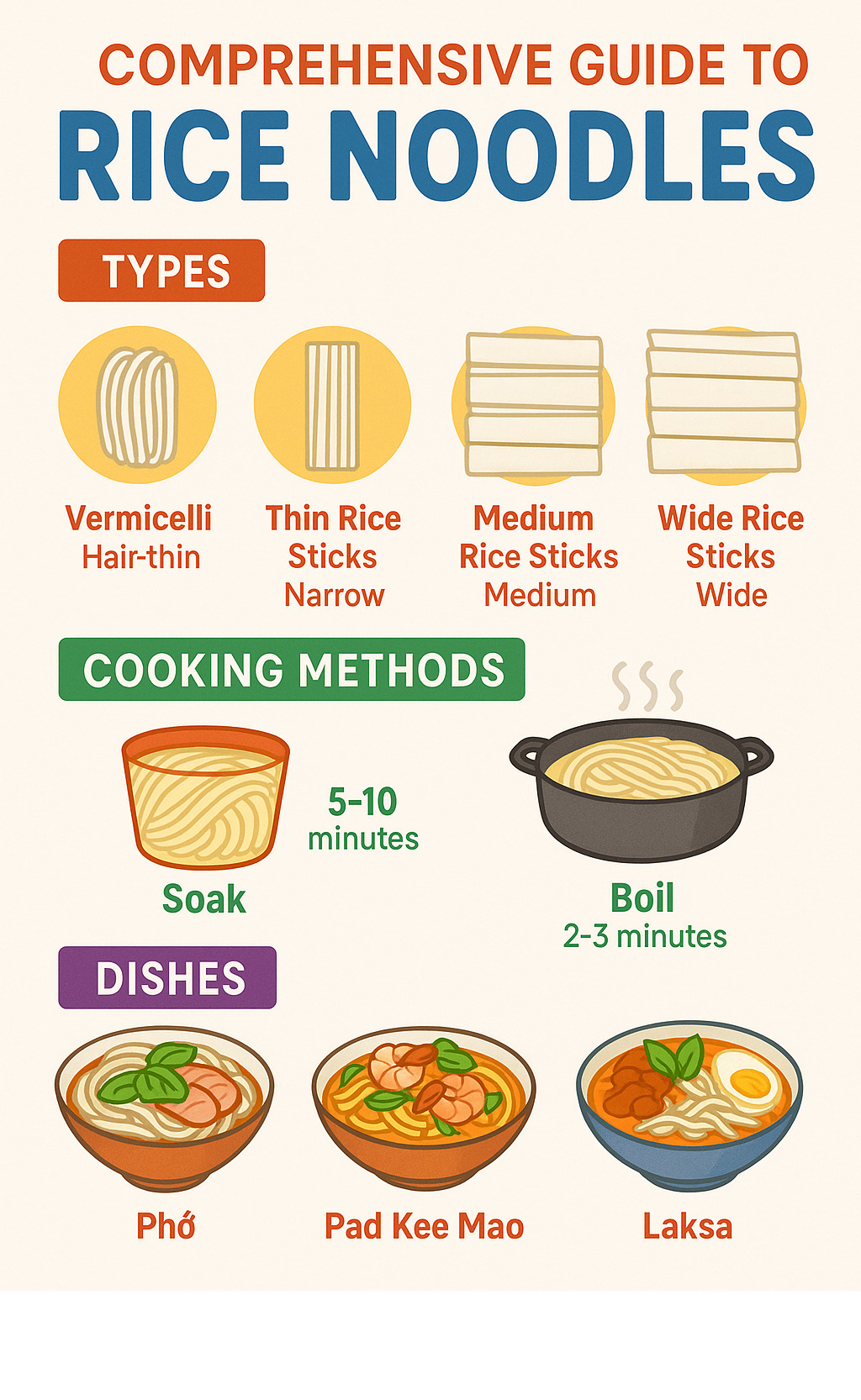
Key rice noodles vocabulary:
Why This Guide Matters
We’ve spent countless hours researching rice noodles – from ancient Chinese texts to modern cooking techniques used in New York City’s best Asian restaurants. This comprehensive guide will transform you from someone who fears these delicate noodles into a confident cook who can nail perfect texture every time.
You’ll find the fascinating history spanning over two millennia, master the differences between dozens of varieties, and learn foolproof cooking methods that prevent the dreaded mushy disaster. Whether you’re planning to recreate authentic global dishes or experiment with modern fusion creations, we’ve got you covered.
From Qin Dynasty to Global Bowl: The History of Rice Noodles
Over 2,000 years ago, during China’s Qin dynasty (221-206 BC), clever cooks in northern China faced a challenge. They knew how to make wheat noodles, but rice was what they had plenty of. So they adapted their wheat noodle techniques to work with rice flour instead.
This wasn’t just some random kitchen experiment – it was pure necessity. Rice grew better in many regions than wheat, and these resourceful cooks weren’t about to let that stop them from enjoying noodles. Little did they know they were creating something that would eventually become a cornerstone of Asian cuisine.
As centuries passed, rice noodles began their journey across Asia. Trade routes like the famous Silk Road didn’t just carry precious goods – they carried knowledge. Merchants, travelers, and migrating families brought rice noodle-making techniques with them, spreading this culinary craft like seeds in the wind.
Each region that adopted rice noodles added their own twist. The addition of tapioca and corn starch came later, as cooks found these ingredients created something special – that beautiful transparency and distinctive chewy texture that makes quality rice noodles so satisfying.
Timeline Highlights
During Ancient China (221-206 BC), those innovative Qin dynasty cooks first cracked the code of adapting wheat noodle techniques for rice flour. This breakthrough laid the foundation for every bowl of pho and plate of pad thai we enjoy today.
The Medieval Period (500-1000 AD) saw rice noodle techniques spreading throughout Southeast Asia like wildfire. Trade routes and migration patterns carried this knowledge far and wide, with each new region putting its own spin on the basic concept.
In the Modern Era (1900s-present), industrial production revolutionized everything. Suddenly, dried rice noodles could travel the globe, making authentic Asian dishes possible in kitchens everywhere.
Cultural Footprints
Vietnam took rice noodles and created something truly magical – bánh phở. These wide, silky ribbons are the soul of every steaming bowl of phở. Vietnamese cooks perfected the art of making these noodles fresh daily, understanding that their delicate, slippery texture was absolutely worth the short shelf life.
Thailand gave the world pad thai noodles, known locally as sen lek. These medium-width flat sticks have the perfect texture to soak up that incredible sweet-savory dance of tamarind, fish sauce, and palm sugar. Thai cooks also pioneered the gentle soaking technique rather than aggressive boiling.
Myanmar showcases how beautifully rice noodles adapt to local flavors in dishes like shan khauk swè. Here, thin rice vermicelli swim in rich, coconut-based broths that perfectly reflect Myanmar’s unique position between Indian and Chinese culinary influences.
Rice Noodle Varieties Explained
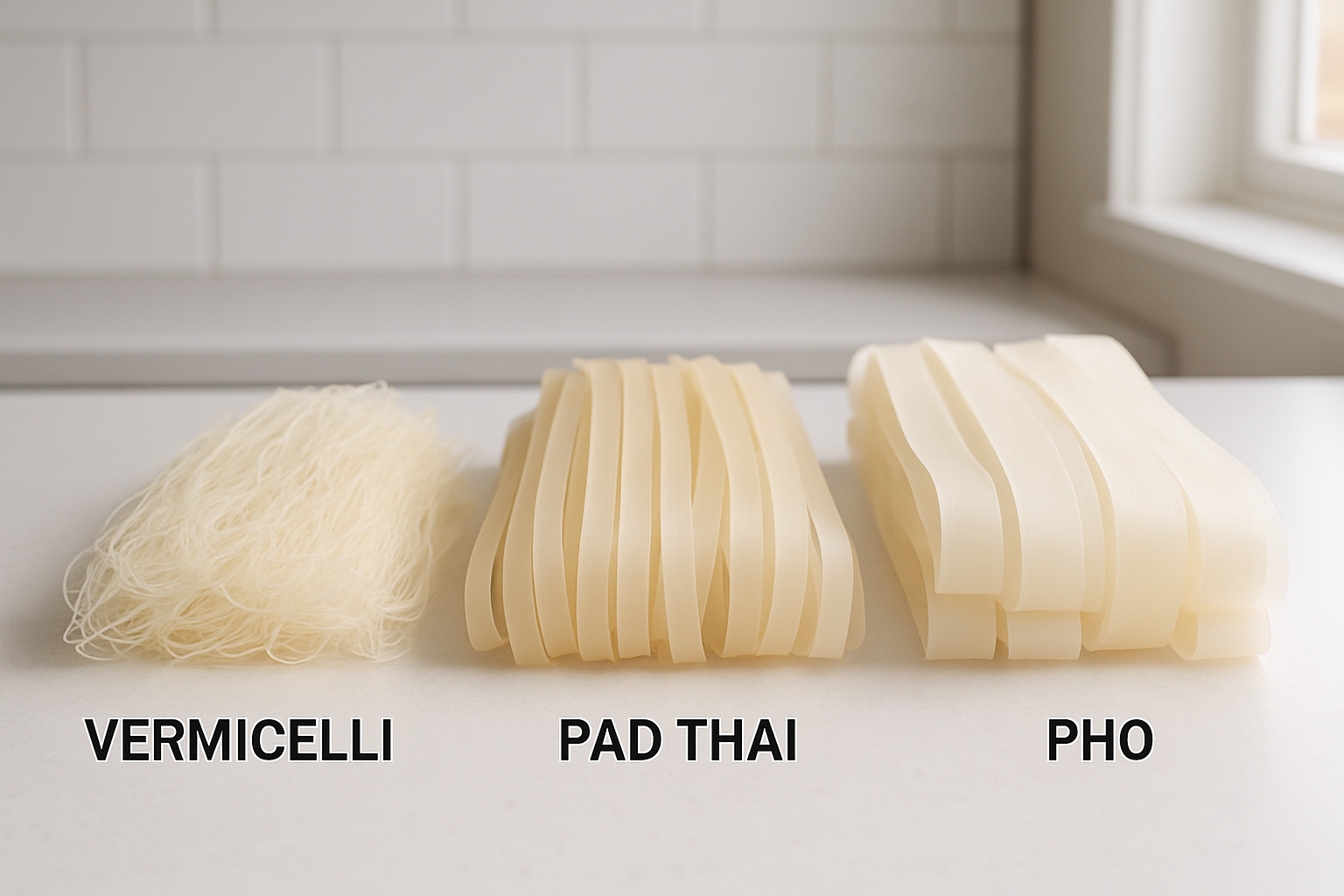
Walking through an Asian grocery store, you’ll find dozens of rice noodles packages – some with clear windows showing hair-thin strands, others hiding thick, chewy ribbons. Each variety has its own personality and purpose, which explains why your pad thai doesn’t taste right when you use phở noodles.
The secret to mastering rice noodles lies in understanding that thickness determines everything – cooking time, texture, and which dishes work best. Think of it like choosing the right pasta shape for Italian cooking, except the stakes feel higher because these delicate noodles can turn to mush in seconds.
Vermicelli are the prima ballerinas of the noodle world – incredibly thin at just 0.5mm diameter, also called rice sticks, mai fun, or bun depending on where you shop. These delicate strands need only 3-5 minutes in room-temperature water to become perfectly tender. They’re designed to fade into the background, letting bold flavors shine in Vietnamese summer rolls or Thai salads.
Flat rice sticks represent the goldilocks zone of rice noodles – not too thin, not too thick, but just right for most home cooking. The classic pad thai width (about 3mm) soaks up in 10 minutes and has enough surface area to grab onto those sweet-savory sauces.
Wide rice sheets are the heavy hitters – bánh phở, shahe fen, and other broad noodles that can handle robust broths and hearty stir-fries. Fresh wide noodles are incredibly delicate, while dried versions need patience – sometimes up to 60 minutes of soaking before they’re ready for the wok.
Thin to Thick: Shape & Size Guide
The diameter of your rice noodles tells you everything you need to know about cooking them. Ultra-thin vermicelli at 0.5mm needs just 3-5 minutes of soaking and works beautifully in light, brothy dishes where you want the noodles to practically disappear.
Medium flat noodles at 3mm wide are your pad thai workhorses, needing about 10 minutes of soaking before they’re ready for the wok. Their flat surface makes them sauce magnets, which is exactly what you want for dishes with complex flavor profiles.
Wide flat noodles at 10mm or wider need serious patience – 30-60 minutes of soaking plus actual cooking time. But they reward you with substantial, satisfying bites that can stand up to rich broths and bold seasonings without falling apart.
Specialty Styles Around Asia
Mixian from China’s Yunnan province comes in two standard sizes – thin at 1.5mm and thick at 3.5-4mm diameter. These round noodles are traditionally paired with complex, slow-simmered broths that have been developing flavor for hours.
Vietnam’s bánh canh breaks all the rules – these thick, chewy tubes can handle anything you throw at them. They’re perfect for robust broths loaded with seafood or meat, and they actually get better as they sit in the soup, absorbing flavors without turning mushy.
Laksa noodles were specifically engineered for Malaysia’s famous spicy coconut curry soup. They’re thick enough to hold their own against that rich, complex broth but still tender enough to slurp gracefully.
| Noodle Type | Diameter | Soak Time | Ideal Dishes | Texture |
|---|---|---|---|---|
| Rice Vermicelli | 0.5mm | 3-5 minutes | Salads, light soups, summer rolls | Delicate, transparent |
| Pad Thai Sticks | 3mm wide | 10 minutes | Stir-fries, pad thai | Chewy, sauce-absorbing |
| Wide Flat | 10mm+ | 30-60 minutes | Hearty stir-fries, pho | Substantial, ricey |
Mastering Preparation: How to Cook Rice Noodles Properly
The biggest mistake home cooks make with rice noodles? Treating them like regular pasta. These delicate strands need a completely different approach – one that’s actually gentler and more forgiving once you understand the basics.
Think of rice noodles as the introverts of the noodle world. They don’t like aggressive boiling or rough handling. Instead, they prefer a calm soak in room-temperature water, followed by a quick finish in your wok or soup pot.
Cooking Rice Noodles 101
The secret to perfect rice noodles lies in understanding that they cook in stages. The soaking phase does most of the work, while the final cooking stage – whether in a stir-fry or soup – just finishes the job.
For hair-thin vermicelli, start with room-temperature water and let them swim for just 3-5 minutes. You’ll know they’re ready when they turn from opaque white to translucent. Drain immediately and give them a cold water rinse to stop the cooking process.
Medium flat noodles – the pad thai superstars – need exactly 10 minutes in room-temperature water. Set a timer! They should feel pliable but still have a tiny bit of resistance when you bite them. After draining, toss them lightly with a neutral oil to prevent clumping.
Wide, thick noodles need up to 60 minutes of soaking in warm (not hot) water, followed by 10-15 minutes of gentle simmering. Never let the water come to a rolling boil – these noodles will literally fall apart under that kind of pressure.
Here’s the game-changing insight: rice noodles continue cooking from residual heat and steam even after you remove them from water. Always undercook them slightly during the soaking phase.
Pro Tips & Common Mistakes
Over-soaking is enemy number one. Even two extra minutes can transform al dente noodles into paste. Test frequently by pulling out a strand and giving it a bite. When it’s almost perfect, drain immediately.
Skipping the oil toss leads to a tangled mess that’s impossible to separate in your wok. After draining, toss those noodles with just a teaspoon of neutral oil – rice bran or vegetable oil works perfectly.
Adding noodles too early ruins stir-fries faster than anything else. Rice noodles should always be the last ingredient you add. Spread them gently over your other ingredients and let the wok steam do the final cooking – usually just 1-2 minutes.
For stir-frying, think gentle lifting and folding rather than aggressive stirring. Use two utensils like you’re folding delicate laundry, not mixing cake batter.
The science behind perfect texture comes down to starch gelatinization – the process that transforms hard, opaque noodles into tender, translucent strands. Scientific research on noodle transparency%202016%20supplementary/(28)%20IFRJ-16328%20Ismail.pdf) shows exactly how this change happens and why gentle heat works better than aggressive boiling.
Nutrition, Allergens & Smart Swaps
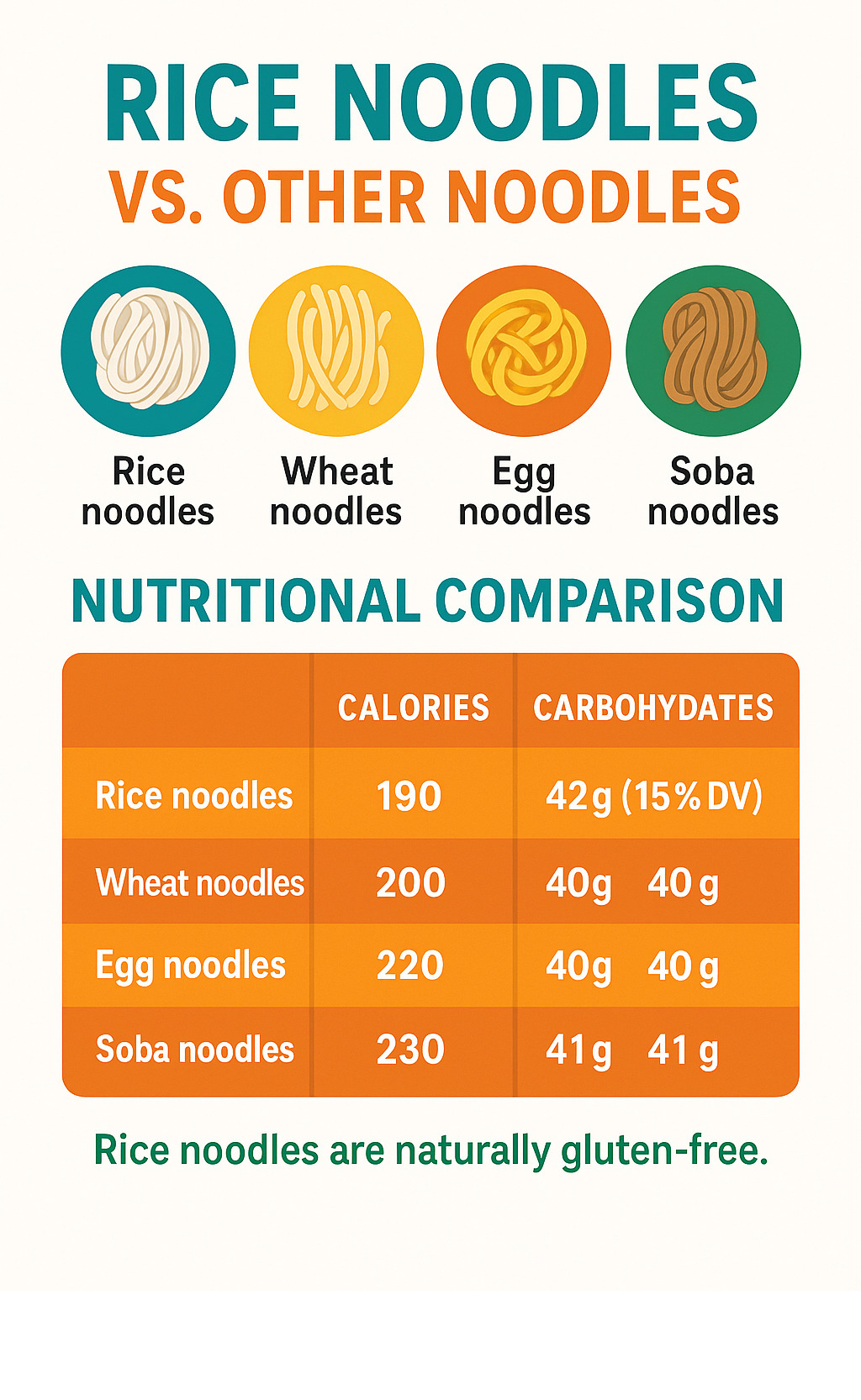
Here’s some fantastic news for anyone dealing with dietary restrictions: rice noodles are naturally gluten-free and made from just two simple ingredients – rice flour and water. That’s it! No hidden wheat, no mysterious additives, just pure rice goodness that’s safe for celiac sufferers and anyone avoiding gluten.
A typical 176g serving of rice vermicelli delivers about 190 calories with 42g of carbohydrates, making them a moderate energy source that won’t weigh you down. You’ll get 3.2g of protein and barely any fat at 0.4g, plus a modest 1.8g of fiber to help with digestion. The sodium content is refreshingly low at just 33mg.
Rice Noodles vs Other Noodles
When you’re standing in the noodle aisle wondering which option to grab, rice noodles offer some unique advantages over their wheat-based cousins. While wheat noodles pack more protein (around 8g per serving), they also contain gluten and have that heavier, chewier texture that doesn’t work in every dish.
Egg noodles bring richness and extra protein to the table, but they’re off-limits for vegans and anyone with egg allergies. Rice noodles give you that clean, neutral base that lets bold Asian flavors truly shine through.
Many people confuse glass noodles (made from mung bean starch) with rice vermicelli when they’re dried. But once cooked, glass noodles become completely transparent with a gelatinous, almost bouncy texture that’s quite different from the tender bite of rice noodles.
The glycemic impact of rice noodles sits in the moderate range, meaning they’ll give you a gentler blood sugar rise compared to refined wheat pasta. Brown rice varieties bump up the fiber content and provide an even steadier energy release.
Diet-Friendly Pairings
The beauty of rice noodles lies in their ability to disappear into the background while letting your favorite proteins and vegetables take center stage. Think of them as the supporting actor that makes everyone else look good.
For plant-based meals, tofu, tempeh, or edamame create complete protein profiles when paired with rice noodles. The mild noodle flavor won’t compete with these ingredients – instead, it creates a satisfying foundation that soaks up all those delicious marinades and sauces.
Lean proteins like chicken breast, shrimp, or white fish work beautifully with rice noodles because they share that light, clean quality. The trick is balancing the mild noodles with bold seasonings – fresh herbs, bright citrus, spicy chilies, and umami-rich sauces like fish sauce or soy sauce.
Don’t forget to load up on colorful vegetables like bell peppers, snap peas, carrots, and leafy greens. Rice noodles provide the satisfying carbs while the vegetables deliver the fiber, vitamins, and minerals your body craves.
Serving, Storage & Modern Fusion Ideas
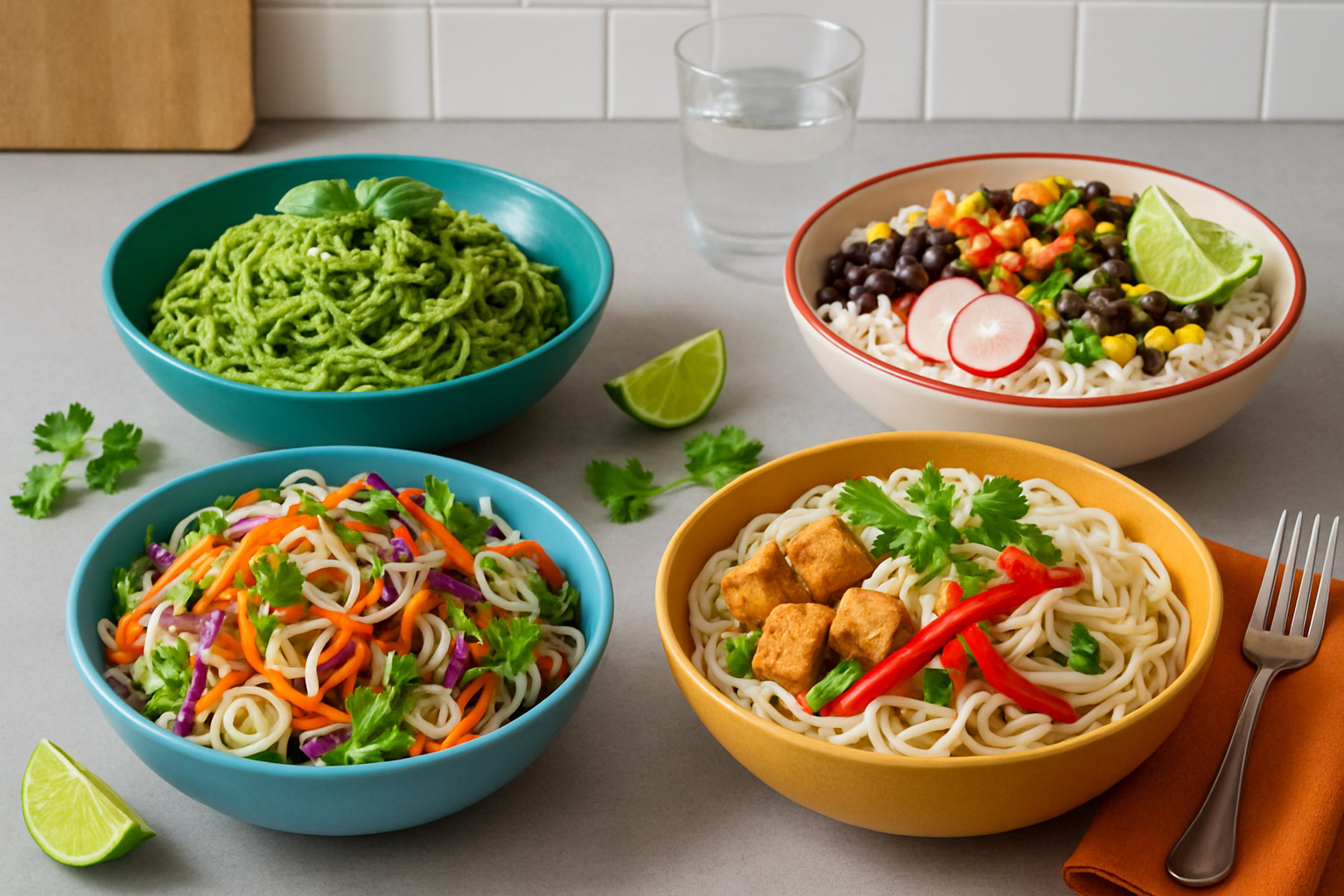
The beauty of rice noodles lies in their incredible adaptability. While they shine in traditional Vietnamese phở and Thai pad thai, we’ve found they’re equally brilliant in unexpected fusion dishes that would make your grandmother from Bangkok raise an eyebrow – in the best possible way.
Cold salad preparations transform rice vermicelli into refreshing summer meals that beat the heat. The noodles act like tiny flavor sponges, soaking up sesame-ginger dressings and mingling beautifully with crisp vegetables and fresh herbs.
When you’re craving quick phở hacks but don’t have eight hours to simmer bones, rice noodles come to the rescue. Use quality store-bought broth as your base, add some star anise and cinnamon for authenticity, and you’ll have a satisfying bowl in under an hour.
Summer rolls showcase rice vermicelli at their most neat. These translucent noodles provide substance without overwhelming the delicate rice paper wrapping or competing with fresh shrimp, herbs, and vegetables.
Storing & Reheating
Dried rice noodles are pantry superstars that laugh in the face of expiration dates. Store them in sealed containers away from dust and moisture, and they’ll reward you with months of reliable service. Just keep them in a cool, dry spot – your kitchen cabinet works perfectly.
Fresh rice noodles are the divas of the noodle world, demanding attention within 2-3 days of purchase. Here’s the counterintuitive part: don’t refrigerate them! Cold temperatures turn these delicate beauties hard and brittle. Instead, keep them at cool room temperature and use them quickly.
Cooked rice noodles need gentle handling in storage. Toss them lightly with neutral oil before refrigerating to prevent the dreaded clumping that turns your leftovers into a solid brick. They’ll stay good for 2-3 days, but never attempt to freeze them – they turn into sad, soggy disappointments when thawed.
Reheating is where many people stumble. Skip the microwave if possible and instead give them a quick toss in a hot skillet with a splash of broth or sauce. If you must use the microwave, add a tablespoon of water and cover to prevent them from drying out.
Fusion & Creative Garnishes
Modern fusion cooking has acceptd rice noodles as the perfect gluten-free pasta alternative, and the results are surprisingly delightful. Pesto rice noodles might sound like culinary blasphemy, but toss warm noodles with basil pesto, cherry tomatoes, and pine nuts, and you’ll understand why this Italian-Asian mashup works so beautifully.
Kimchi stir-fries bring Korean fire to delicate rice noodles. The fermented heat and tanginess of kimchi creates an incredible contrast with the mild noodles, especially when you add a drizzle of sesame oil and fresh scallions.
Sesame-ginger cold noodles are meal prep champions that actually improve as they sit, absorbing more flavor over time. Make a big batch on Sunday, and you’ll have satisfying lunches all week.
Creative garnishes can transform simple rice noodle dishes into restaurant-worthy presentations. Crispy fried shallots add sweetness and crunch, while fresh herb combinations like cilantro, mint, and Thai basil provide aromatic complexity. Toasted sesame seeds contribute nutty depth, chili oil brings glossy heat, and lime wedges add that essential brightness that ties everything together.
For more fusion inspiration that’ll expand your culinary horizons, explore our World Cuisine Exploration guide.
Kitchen Gear Essentials
Success with rice noodles isn’t just about technique – having the right tools makes the difference between frustration and culinary triumph. A large pot gives you room to soak multiple portions without crowding, while a wok or large skillet provides the high, sloped sides that make tossing noodles graceful rather than messy.
A fine-mesh colander prevents thin vermicelli from escaping during draining. Tongs or two utensils allow for gentle lifting and folding rather than aggressive stirring that breaks delicate noodles.
For smaller batches and sauce preparation, this Saucepan – Medium Saucepan – MediumSkillet handles everything from reheating leftovers to creating the perfect pad thai sauce that’ll make your rice noodles sing.
Frequently Asked Questions about Rice Noodles
Do I need to soak all dried rice noodles first?
Absolutely! Every single type of dried rice noodles needs soaking before you can use them – there’s no shortcut here. But the soaking time varies dramatically.
Those delicate vermicelli noodles? They’re ready in just 3-5 minutes of room-temperature water. Meanwhile, thick rice noodles are the marathon runners of the noodle world – they might need a full hour of warm water soaking, followed by a brief cooking session.
The soaking process is what transforms those brittle, chalk-like dried noodles into the silky, tender strands that make Vietnamese phở and Thai pad thai so irresistible. Skip this step, and you’ll end up with crunchy disappointment in your bowl.
How can I keep rice noodles from sticking together?
The sticky situation with rice noodles is probably the most common kitchen frustration we hear about. The good news? It’s completely preventable with the right technique.
The moment you drain your soaked noodles, toss them immediately with a small drizzle of neutral oil – vegetable or rice bran oil works perfectly. This creates a protective coating that prevents the noodles from welding themselves together into one giant clump.
If you’re not cooking them right away, spread the oiled rice noodles on a plate rather than leaving them piled in a bowl. Think of it like laying out wet laundry – they need space to breathe.
During stir-frying, add the noodles last and treat them gently. Use a lifting and folding motion with your utensils rather than aggressive stirring. We like to think of it as tucking the noodles into bed rather than wrestling with them.
Are brown-rice noodles healthier than white?
Brown rice noodles are definitely the nutritional overachievers of the rice noodles family. They pack more fiber, B vitamins, and minerals than their white rice cousins, making them a smart choice if you’re looking to boost the nutritional value of your meals.
The trade-off comes in texture and flavor – brown rice noodles have a nuttier taste and slightly denser feel that some people love and others find too heavy. They work beautifully in most recipes that call for regular rice noodles, though they might change the overall character of delicate dishes like Vietnamese summer rolls.
The biggest challenge is finding them. Brown rice noodles are still the specialty item in most grocery stores, and they typically cost more than white varieties. But they’re becoming increasingly available in health food stores and online.
If you’re managing blood sugar or just want more nutrients from your noodles, brown rice versions are worth seeking out. Just remember that their stronger flavor works best in dishes with bold seasonings that can stand up to their nuttier character.
Conclusion
Your journey through rice noodles has taken you from ancient Chinese kitchens to modern fusion experiments, and now you’re equipped with the knowledge that transforms these simple ingredients into culinary magic.
Think about what you’ve finded: rice noodles aren’t just gluten-free pasta substitutes – they’re cultural ambassadors that have been connecting flavors across Asia for over 2,000 years. Each variety tells a story, from delicate Vietnamese vermicelli that dissolves into aromatic phở broth to substantial Thai flat noodles that cradle sweet-savory pad thai sauce.
The cooking techniques you’ve mastered will serve you well beyond Asian cuisine. Understanding that gentle soaking beats aggressive boiling, that oil prevents sticking, and that timing is everything – these principles apply whether you’re recreating street food memories or inventing your own fusion dishes in your New York City kitchen.
We’ve seen how these humble noodles made from rice flour and water offer remarkable versatility. They’re naturally gluten-free, making them accessible to anyone with dietary restrictions. They’re quick-cooking, perfect for busy weeknight meals. Most importantly, their neutral flavor makes them the ideal canvas for bold seasonings, fresh herbs, and creative combinations.
Your experiments don’t have to stop with traditional preparations. Try that pesto rice noodle fusion we mentioned, or toss vermicelli with kimchi and sesame oil for a Korean-Italian mashup that shouldn’t work but absolutely does. The beauty of rice noodles lies in their adaptability – they welcome innovation while honoring tradition.
Remember the key lessons: room-temperature soaking for thin varieties, gentle handling during stir-frying, and adding noodles last to prevent overcooking. These simple techniques separate soggy disasters from restaurant-quality results.
At The Dining Destination, we believe that mastering ingredients like rice noodles opens doors to authentic global experiences right in your own kitchen. Food connects us across cultures and continents, and these techniques help you participate in that beautiful exchange.
Start with confidence. Perfect your vermicelli technique first, then gradually explore thicker varieties and more complex dishes. Before long, you’ll be the friend everyone asks for rice noodle cooking advice, sharing the same knowledge that’s been passed down through generations of Asian cooks.
For more comprehensive cooking guides and culinary trips that bring the world to your table, explore our resource-guide and continue finding the stories that make food so much more than just sustenance.

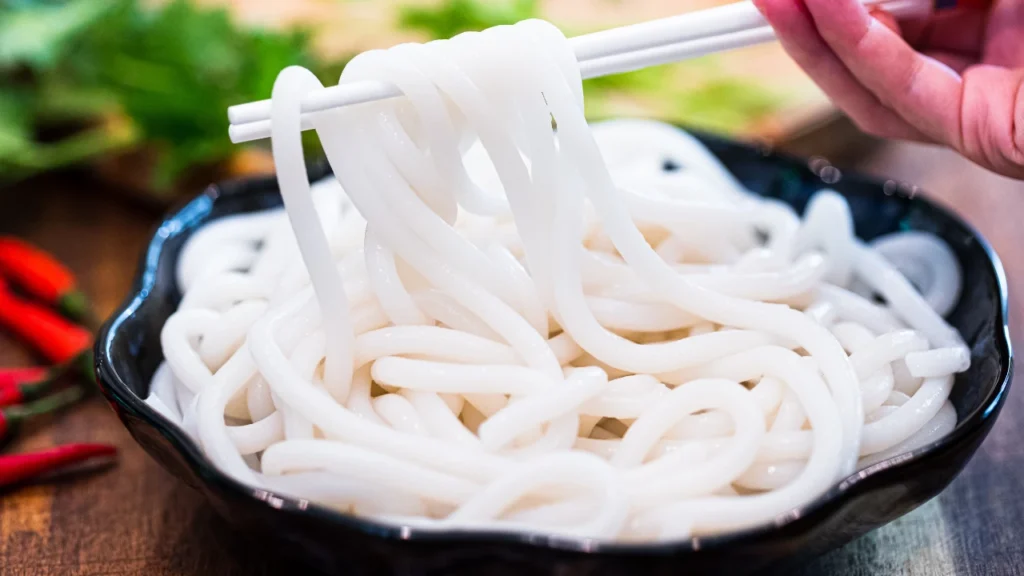

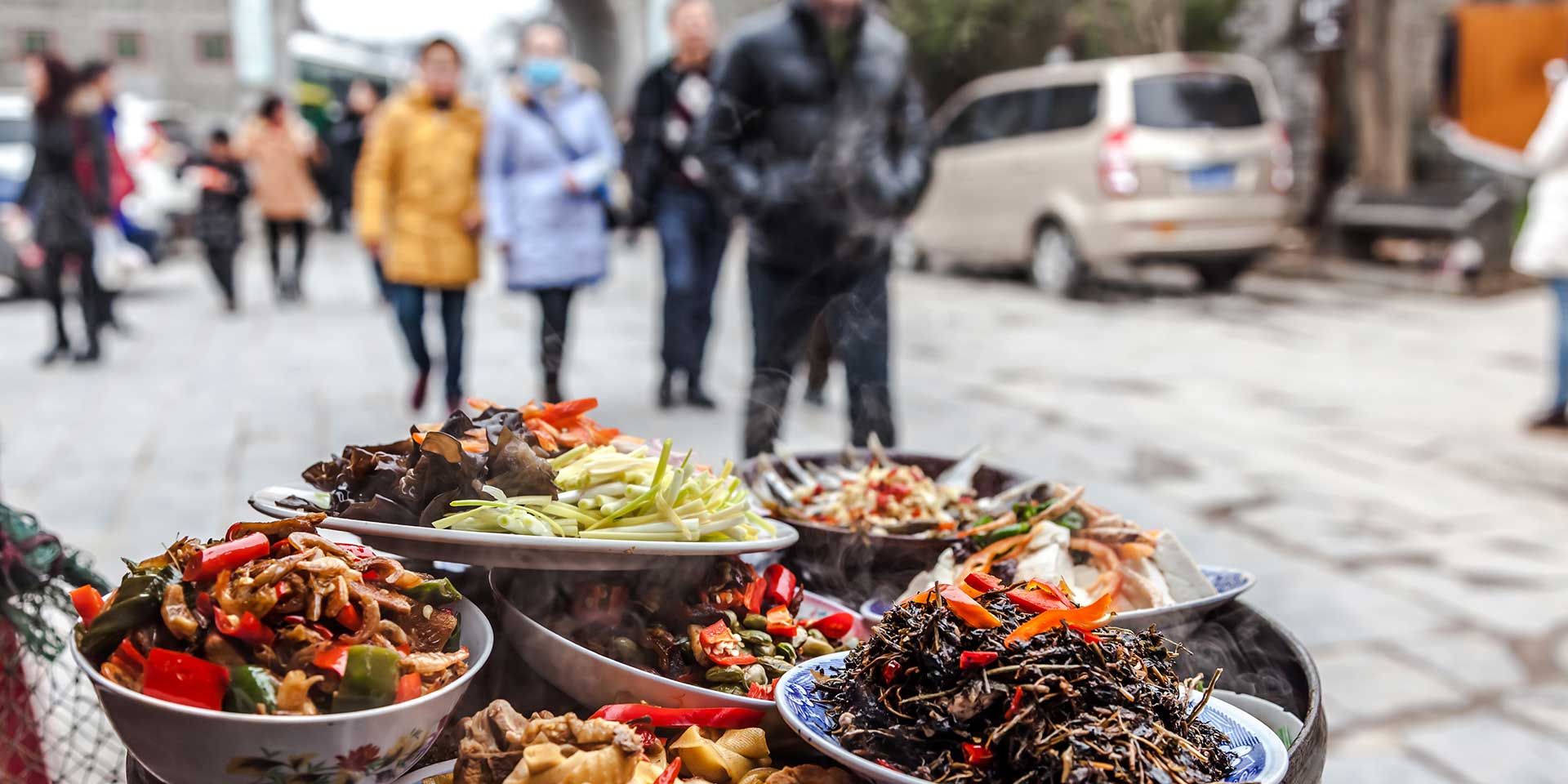




1 thought on “The Complete Guide to Rice Noodles: Types, Uses, and Tips”
Pingback: The Ultimate Guide to Dumplings: Types, History, and Recipes - The Dining Destination
Comments are closed.